Spatiotemporal Patterns and Driving Factors of Non-Grain Cultivated Land in China’s Three Main Functional Grain Areas
Abstract
:1. Introduction
2. Materials and Methods
2.1. Study Area
2.2. Data Collection
2.3. Research Framework
2.4. Spatial Autocorrelation Analysis
2.4.1. Global Spatial Autocorrelation
2.4.2. Local Spatial Autocorrelation
2.5. Regression Analysis Model
3. Results
3.1. Overall Characteristics of Non-Grain Cultivated Land
3.1.1. Change over Time
3.1.2. Diversity of Non-Grain Crops
3.2. Spatial Pattern and Differentiation Characteristics of Non-Grain Cultivated Land
3.2.1. Spatial Agglomeration Characteristics
3.2.2. Spatial Differentiation Characteristics of Functional Grain Areas
3.3. Driving Factors of Chinese Non-Grain Cultivated Land
3.3.1. Variable Selection
3.3.2. Analysis of the Driving Factors
4. Discussion
5. Conclusions and Recommendations
5.1. Conclusions
5.2. Recommendations
Author Contributions
Funding
Institutional Review Board Statement
Informed Consent Statement
Data Availability Statement
Acknowledgments
Conflicts of Interest
References
- Hu, J.; Wang, H.; Song, Y. Spatio-temporal evolution and driving factors of “non-grain production” in Hubei province based on a non-grain index. Sustainability 2023, 15, 9042. [Google Scholar] [CrossRef]
- Chen, F.; Liu, J.; Chang, Y. Spatial pattern differentiation of non-grain cultivated land and its driving factors in China. China Land Sci. 2021, 35, 33–43. [Google Scholar]
- Liang, X.; Jin, X.; Liu, J.; Yin, Y.; Gu, Z.; Zhang, J.; Zhou, Y. Formation mechanism and sustainable productivity impacts of non-grain croplands: Evidence from Sichuan Province, China. Land Degrad. Dev. 2023, 34, 1120–1132. [Google Scholar] [CrossRef]
- Liu, G.; Zhao, L.; Chen, H. Does farmland transfer lead to non-grain production in agriculture?—An Empirical Analysis Based on the Differentiation of Farmland Renting-In Objects. Sustainability 2023, 15, 379. [Google Scholar] [CrossRef]
- Liu, Z.; Zhong, H.; Li, Y.; Wen, Q.; Liu, Z.; Liu, X.; Zhong, H.; Jian, Y.; Li, Y.; Wen, Q. Change in grain production in China and its impacts on spatial supply and demand distributions in recent two decades. J. Nat. Resour. 2021, 36, 1413–1425. [Google Scholar] [CrossRef]
- Sayer, J.; Ghazoul, J.; Nelson, P.; Klintuni Boedhihartono, A. Oil palm expansion transforms tropical landscapes and livelihoods. Glob. Food Secur. 2012, 1, 114–119. [Google Scholar] [CrossRef]
- Meyfroidt, P.; Carlson, K.M.; Fagan, M.E.; Gutiérrez-Vélez, V.H.; Macedo, M.N.; Curran, L.M.; DeFries, R.S.; Dyer, G.A.; Gibbs, H.K.; Lambin, E.F. Multiple pathways of commodity crop expansion in tropical forest landscapes. Environ. Res. Lett. 2014, 9, 074012. [Google Scholar] [CrossRef]
- Chen, M. Analysis on the phenomenon and countermeasures of “non-grain” of cultivated land. China Land. 2021, 4, 9–10. [Google Scholar]
- Li, Y.; Zhao, B.; Huang, A.; Xiong, B.; Song, C. Characteristics and driving forces of non-grain production of cultivated land from the perspective of food security. Sustainability 2022, 13, 14047. [Google Scholar] [CrossRef]
- Su, Y.; Qian, K.; Lin, L.; Wang, K.; Guan, T.; Gan, M. Identifying the driving forces of non-grain production expansion in rural China and its implications for policies on cultivated land protection. Land Use Policy 2020, 92, 104435. [Google Scholar] [CrossRef]
- Kong, X. Problems, causes and countermeasures of “non-grain” cultivated land. China Land 2020, 11, 17–19. [Google Scholar]
- Qiu, T.; Boris Choy, S.T.; Li, S.; He, Q.; Luo, B. Does land renting-in reduce grain production?—Evidence from rural China. Land Use Policy 2020, 90, 104311. [Google Scholar] [CrossRef]
- Zhu, D. Economic mechanism and governance path of “non-grain” of cultivated land. China Land 2021, 7, 9–11. [Google Scholar]
- Cao, Y.; Li, G.; Wang, J. Systematic review and research framework of “non-grain” utilization of cultivated land: From a perspective of food security to multidimensional security. China Land Sci. 2022, 36, 1–12. [Google Scholar]
- Zhang, D.; Yang, W.; Kang, D. Spatial-temporal characteristics and policy implication for non-grain production of cultivated land in Guan Zhong Region. Land Use Policy 2022, 12, 106466. [Google Scholar]
- Guan, X.; Wang, X.; Zhao, Y. Morphological characteristics identification and optimization of “non-grain” cultivated land along Yellow River Basin. Trans. Chin. Soc. Agric. Mach. 2021, 52, 233–242. [Google Scholar]
- Zhang, H.; Song, W.; Zhang, W. Analysis of spatial differentiation characteristics and influencing factors of non-grain cultivated land in Shandong Province. China Land Sci. 2021, 35, 94–103. [Google Scholar]
- Wang, P.; Zhang, L.; Lu, Y. Study on the spatial-temporal evolution an influencing factors of non-grain cultivated land in Guangxi. Chin. J. Agric. Resour. Reg. Plan. 2023, 44, 187–197. [Google Scholar]
- Wang, F.; Liu, Y.; Kong, X. Spatial and temporal variation of grain production and its influencing factors at the county level in China. Econ. Geogr. 2018, 38, 142–151. [Google Scholar]
- Wen, J.; Zhang, C.; Zhang, L. Spatiotemporal evolution and influencing factors of Chinese grain production under climate change. J. Henan Univ. (Nat. Sci.) 2020, 50, 652–665. [Google Scholar]
- Zhang, Y.; Feng, Y.; Wang, F. Spatiotemporal differentiation and driving mechanism of cultivated land non-grain conversion in Guangdong Province. Resour. Sci. 2022, 44, 480–493. [Google Scholar] [CrossRef]
- Cai, R.; Chen, W.; Zhu, X. Cost benefit: The internal cause and the key to break the non-grain transformation of cultivated land circulation. Rural Econ. 2015, 7, 44–49. [Google Scholar]
- Wu, Y.; Zhang, P.; Yu, Y. Progress review on and prospects for non-grain cultivated land in China from the perspective of food security. China Land Sci. 2021, 35, 116–124. [Google Scholar]
- Meng, F.; Tan, Y.; Chen, H. Spatial-temporal evolution patterns and influencing factors of “non-grain” utilization of cultivated land in China. China Land Sci. 2022, 36, 97–106. [Google Scholar]
- Zhang, J.; Li, X.; Xie, S.; Xia, X. Research on the influence mechanism of land tenure security on farmers’ cultivated Land Non-Grain behavior. Agriculture 2022, 12, 1645. [Google Scholar] [CrossRef]
- Zhou, D.; Wu, J.; Wen, W. Abandonment characteristics and influencing factors of cultivated land abandonment in major crop-producing areas. Trans. Chin. Soc. Agric. Mach. 2021, 52, 127–137. [Google Scholar]
- Gai, M.; Yang, Q.; He, Y. Spatiotemporal changes and influencing factors of agricultural green development level in main grain-producing areas in Northeast China. Resour. Sci. 2022, 44, 927–942. [Google Scholar] [CrossRef]
- Ma, L.; Zhang, R.; Pan, Z. Analysis of the evolution and influencing factors of temporal and spatial pattern of eco-efficiency of cultivated land use among provinces in China: Based on panel data from 2000 to 2019. China Land Sci. 2022, 36, 74–85. [Google Scholar]
- Chang, Y.; Liu, J.; Ma, J.; Yu, H.; Chen, F. Spatial pattern and driving factors of non-grain conversion on cultivated land in arid and semi-arid regions. J. Agri. Resour. 2023, 40, 333–344. [Google Scholar]
- Wang, D.; Lv, B.; Ding, W. Analysis on the evolution and influencing factors of spatial pattern of grain production in Yunnan Province. Inq. Econ. Issues 2021, 12, 136–148. [Google Scholar]
- Zhu, L.; Lu, Q. The use efficiency of cultivated land and irrigation water and the spatial correlation analysis of its coupling coordination in China. J. China Agric. Univ. 2022, 27, 297–308. [Google Scholar]
- Wei, X.; Lin, L.; Luo, P. Spatiotemporal pattern and driving force analysis of multi-functional coupling coordinated development of cultivated land. Trans. Chin. Soc. Agric. Eng. 2022, 38, 260–269. [Google Scholar]
- Zeng, Y.; Lv, Y.; Cai, J. Does the farmland and transfer lead to “non-grain production” in agriculture? J. Northwest A F Univ. (Soc. Sci. Ed.) 2018, 18, 123–130. [Google Scholar]
- Huang, T.; Lu, Z.; Zheng, H. The formation characteristics of non-grain cultivated land in the urban suburb under the peasant household scale- a case study of Guangfo area. Rural Econ. Sci. Technol. 2022, 33, 68–72. [Google Scholar]
- Zhao, X.; Zheng, Y.; Huang, X. The effect of urbanization and farmland transfer on the spatial patterns of non-grain farmland in China. Sustainability 2017, 9, 1438. [Google Scholar] [CrossRef]
- Chen, Y.; Li, X.; Zhu, H.; Zhao, Y. Comparison of the agricultural land use changes at different economic level. J. China Agric. Univ. 2011, 16, 124–131. [Google Scholar]
- Chen, L.; Hu, Y.; Han, X.; Guo, X. The quantitative comparative analysis of food production and contributions of major grain production areas in national food security. China Land Sci. 2017, 31, 34–42. [Google Scholar]
- Liu, H.; Zhang, L. Will the transfer of agricultural land lead to the “non-grain” growing? Rural Econ. 2020, 11, 45–53. [Google Scholar]
- Gao, Y.; Zhang, Z.; Wang, Z. Land transfer, appetite for risk and crop pattern—Empirical analysis based on micro data of CHFS. J. Agrotech. Econ. 2021, 8, 66–80. [Google Scholar]
- Xie, H.; Ouyang, Z.; Chen, Q. Does cultivated land fragmentation promote “Non-grain” utilization of cultivated land: Based on a micro survey of farmers in the Hilly and Mountainous Areas of Fujian. China Land Sci. 2022, 36, 47–56. [Google Scholar]
- Song, G.; Zhang, W. Spatiotemporal differentiation characteristics of cultivated land use from perspective of growing food crops in major grain production areas in northeast China. Trans. Chin. Soc. Agric. Eng. 2020, 36, 1–8. [Google Scholar]
- Su, Y.; Li, C.; Wang, K.; Deng, J.; Shahtahmassebi, A.R.; Zhang, L.; Ao, W.; Guan, T.; Pan, Y.; Gan, M. Quantifying the spatiotemporal dynamics and multi-aspect performance of non-grain production during 2000–2015 at a fine scale. Ecol. Indic. 2019, 101, 410–419. [Google Scholar] [CrossRef]
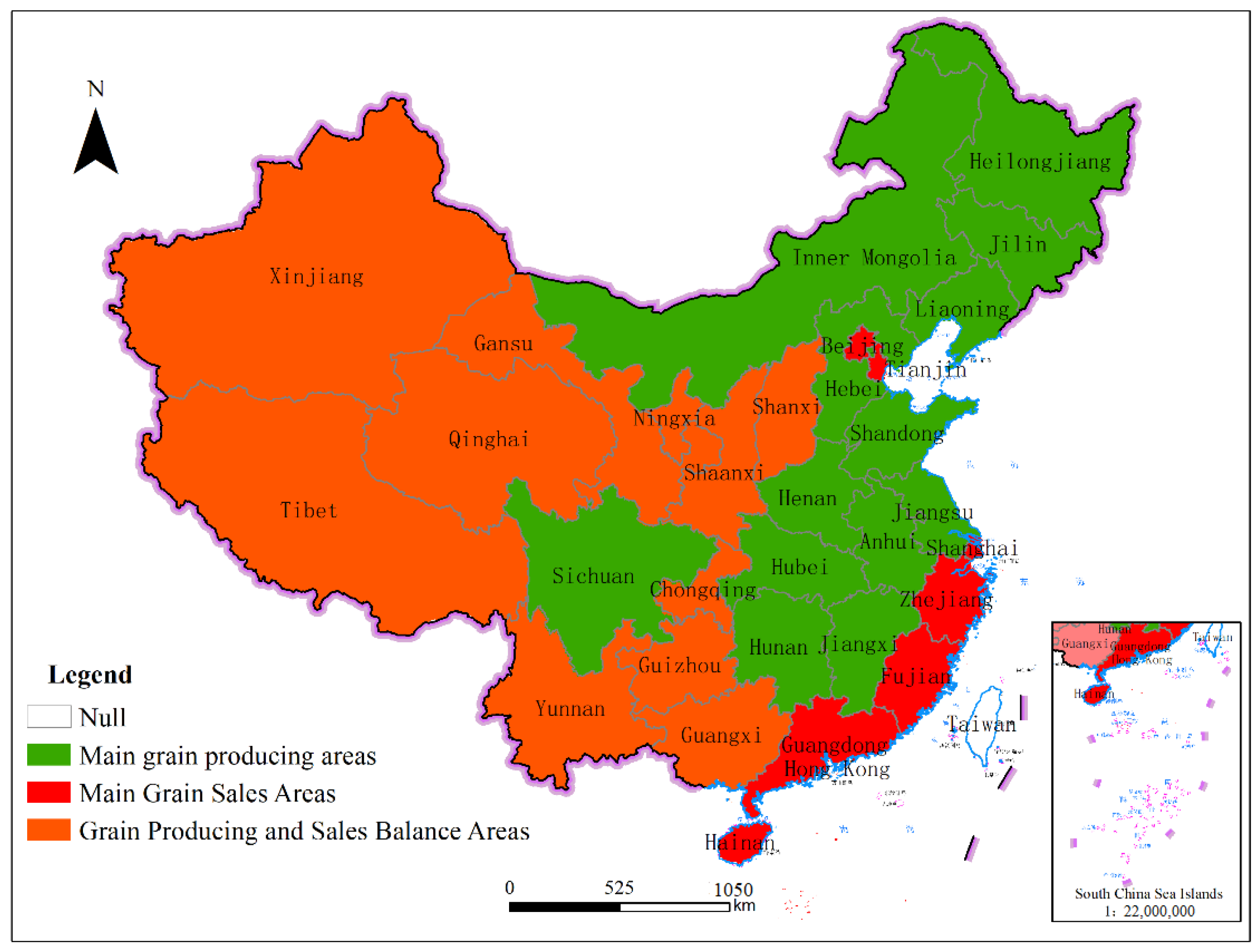
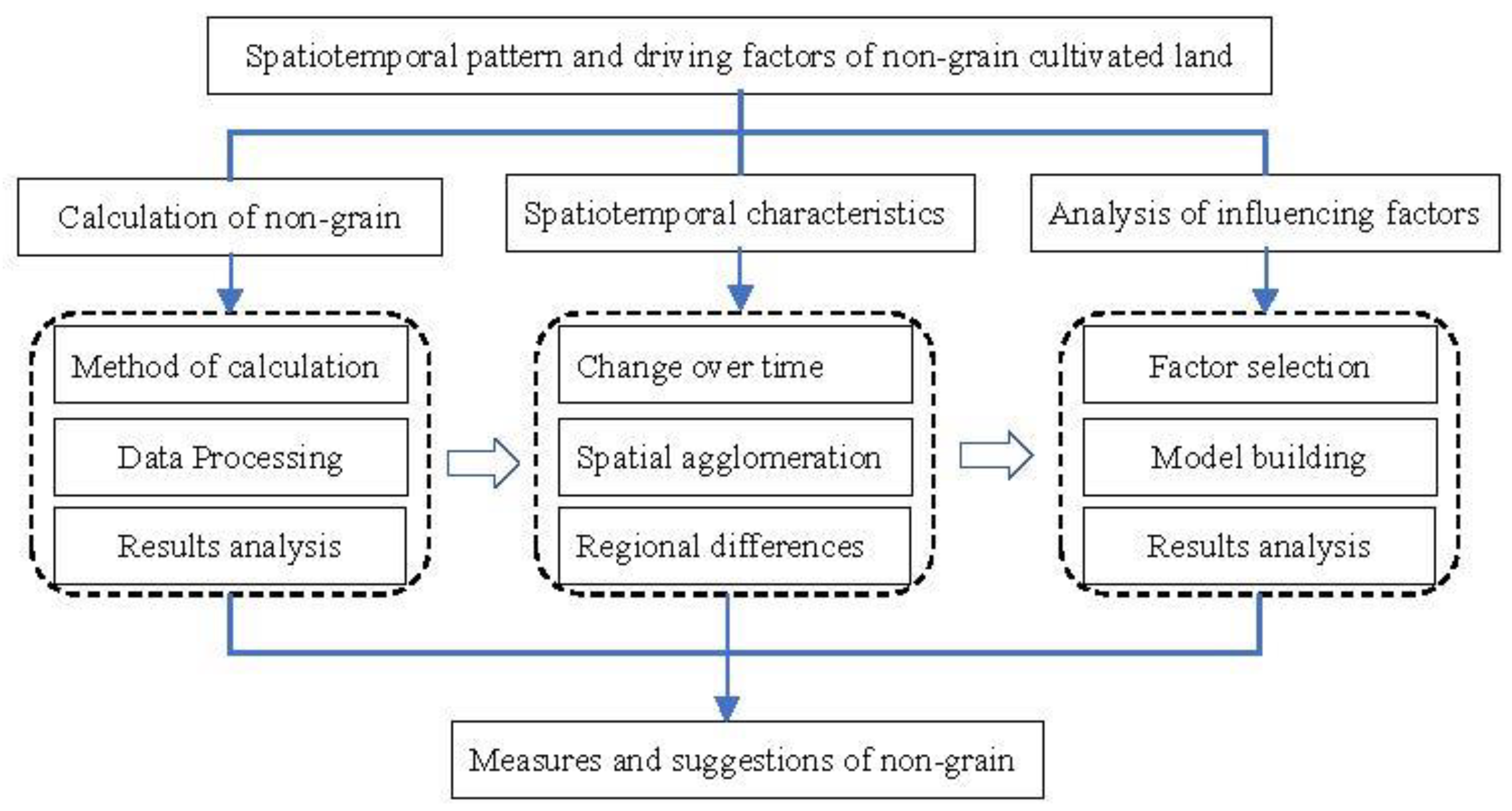

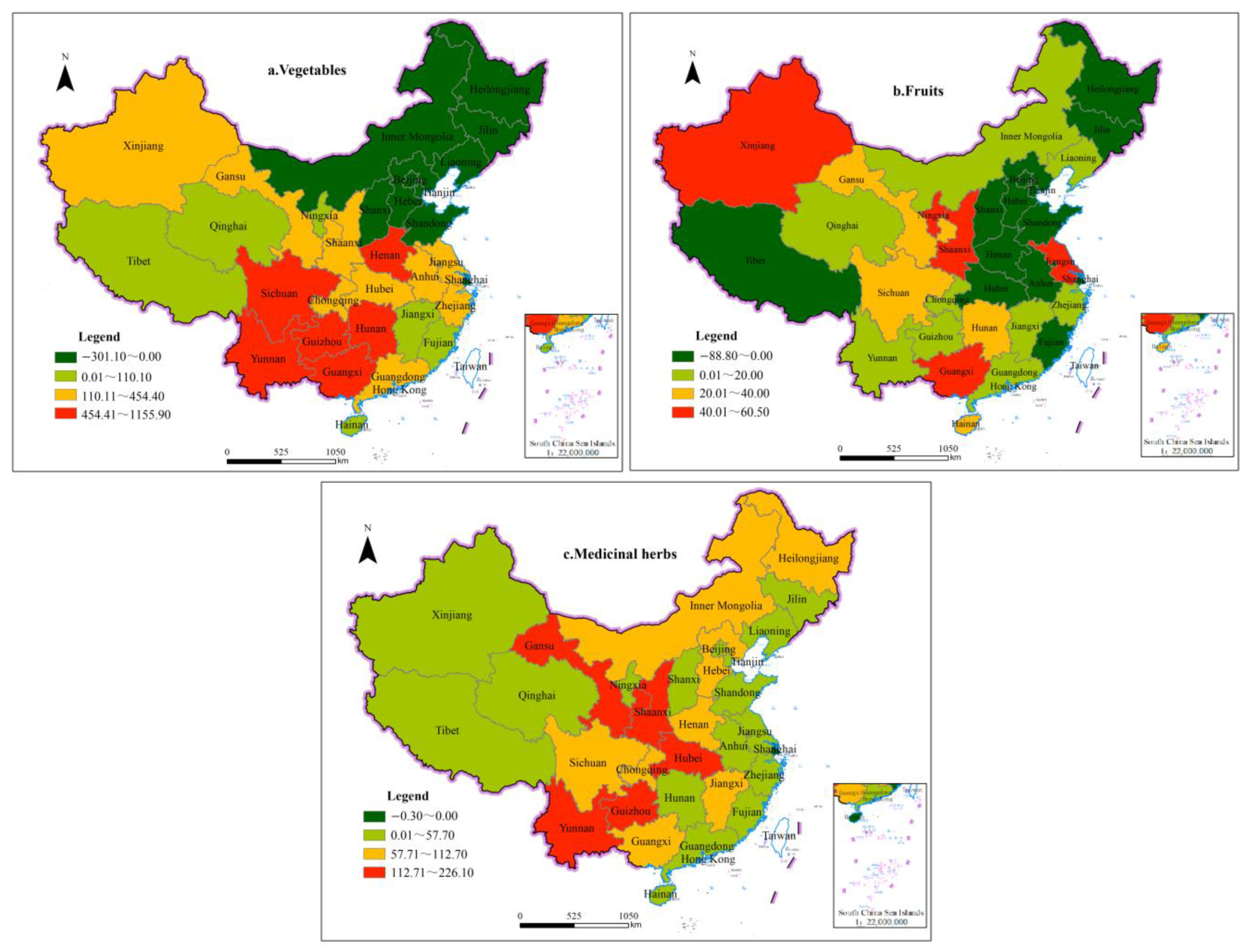
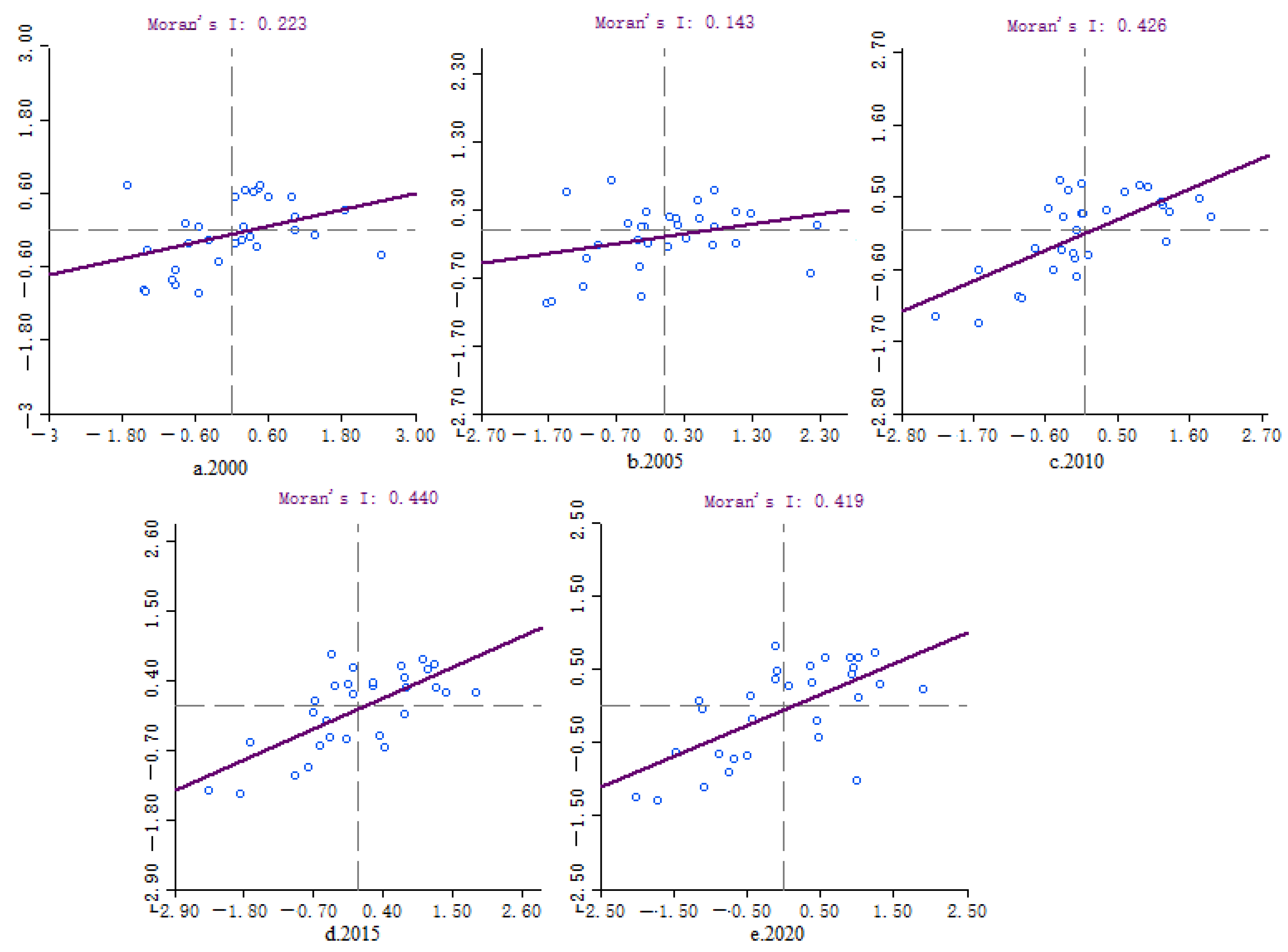
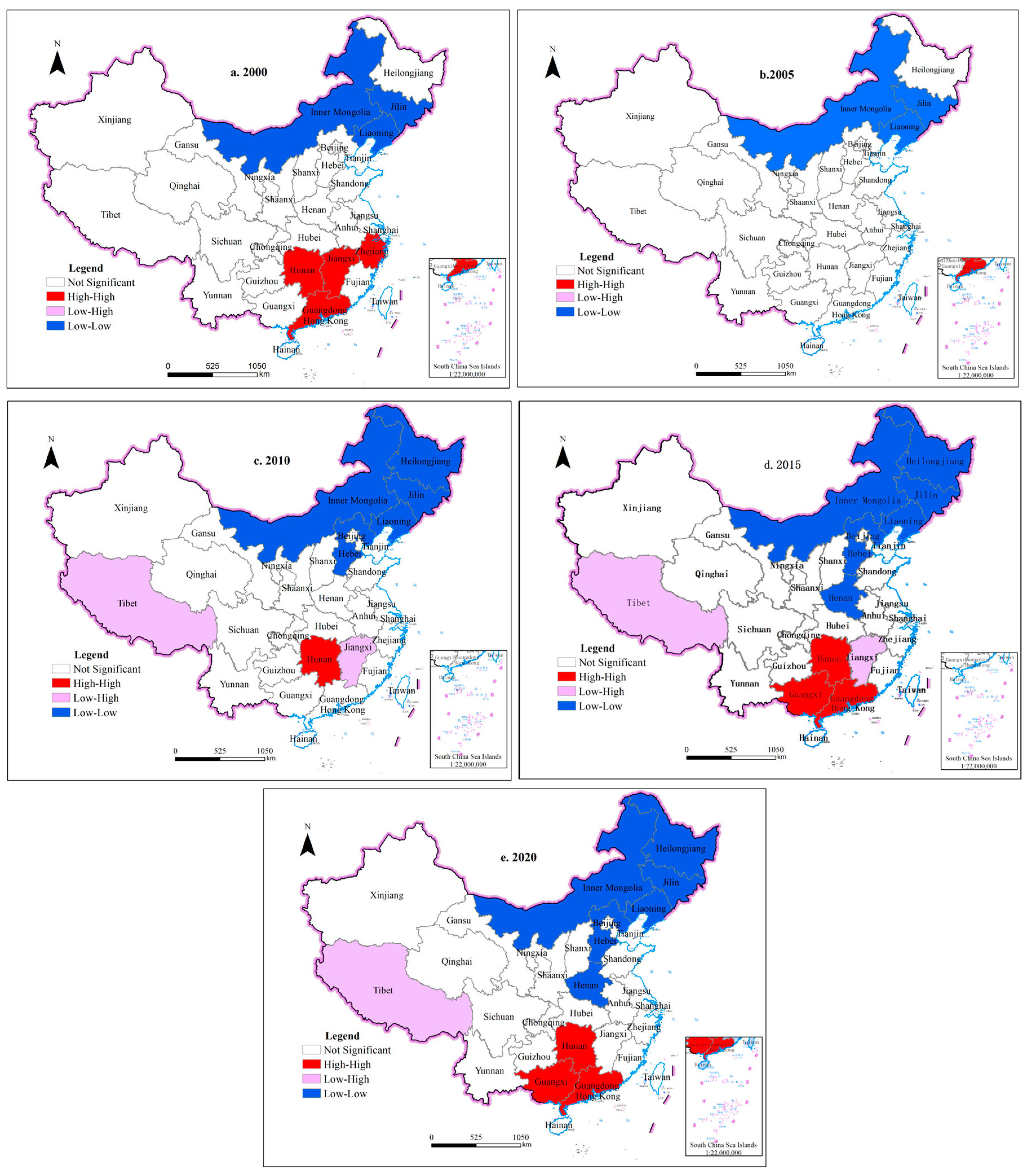
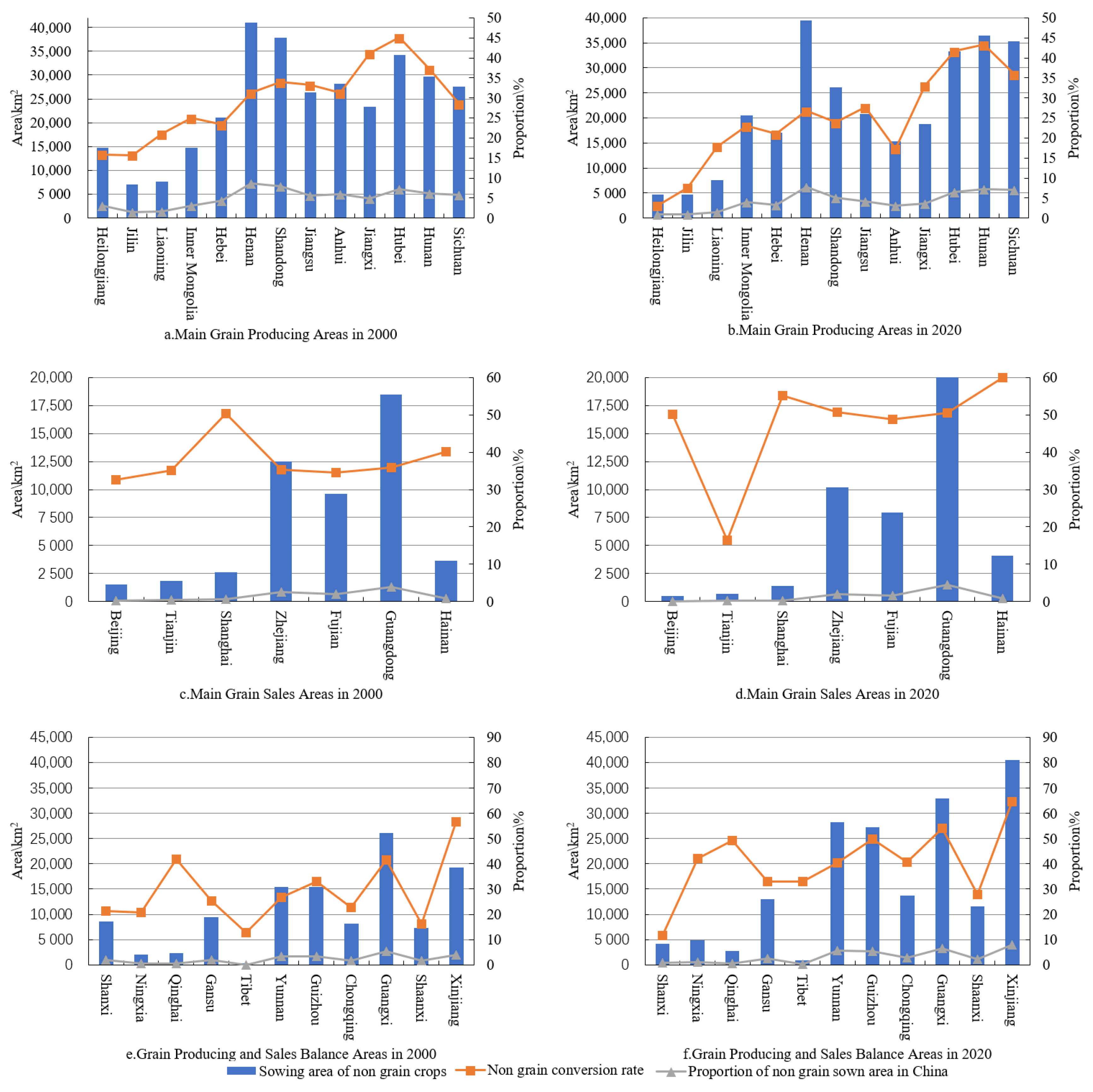
| Year | Non-Grain Crops (km2) | ||||||||
|---|---|---|---|---|---|---|---|---|---|
| Oil Crops | Cotton | Fiber Crops | Vegetables | Fruits | Medicinal Herbs | Sugar Crops | Tobacco | Green Fodder | |
| 2000 | 154,003 | 40,412 | 2617 | 152,373 | 20,437 | 6756 | 15,142 | 14,372 | 21,418 |
| 2020 | 131,291 | 31,689 | 686 | 214,855 | 21,619 | 29,051 | 15,685 | 10,139 | 21,992 |
| Variation | −22,712 | −8723 | −1931 | 62,482 | 1182 | 22,295 | 543 | −4233 | 574 |
| Proportion (%) | −14.75 | −21.59 | −73.79 | 41.01 | 5.78 | 330.00 | 3.59 | −29.45 | 2.68 |
| Category | Driving Factor | Definitions |
|---|---|---|
| Resource endowment | Cultivated area (x1) | Total area of cultivated land in the region, reflecting the abundance or shortage of cultivated land resources. |
| Cultivated land area per capita of agricultural population (x2) | Total area of cultivated land divided by the agricultural population, reflecting the abundance or scarcity of cultivated land resources per capita. | |
| Grain yield per unit area (x3) | Grain yield divided by the grain sowing area, reflecting the production capacity of cultivated land. | |
| Factor input | Total mechanical power per unit of cultivated land area (x4) | Total power of agricultural machinery divided by cultivated land area, reflecting the intensity of scientific and technological investment. |
| Proportion of effective irrigation area (x5) | The proportion of cultivated land area that can be irrigated normally to the total cultivated land area, reflecting the drought resistance of cultivated land and revealing the guaranteed conditions of cultivated land water sources. | |
| Social development | Rural population (x6) | Number of rural permanent residents in the region, reflecting the situation of rural surplus labor force. |
| Agricultural proportion of labor force (x7) | Agricultural employees as a proportion of total employees in the region, reflecting the structure of the agricultural labor force. | |
| Urbanization rate (x8) | Ratio of urban population to total population, reflecting the level of urbanization in the region. | |
| Economic level | Per capita GDP (x9) | Regional GDP divided by regional population, reflecting the regional economic level. |
| Income ratio of urban and rural residents (x10) | The ratio of per capita disposable income of urban residents to per capita disposable income of rural residents, reflecting the urban–rural income gap. | |
| Agricultural output value (x11) | Total agricultural output value as a proportion of gross regional product, reflecting the regional industrial structure. | |
| Rural Engel coefficient (x12) | Food expenditure as a proportion of total consumption expenditure in rural households, reflecting the living standards of rural residents. | |
| Policy regulation | Number of agricultural cooperatives (x13) | Number of farmer cooperatives in the region, reflecting the regional level of agricultural socialization services. |
| Land transfer rate (x14) | Transferred cultivated land area as a proportion of the total cultivated land area, reflecting the degree of large-scale management of cultivated land. |
| Region | OLS Regression Model Fitting Results | R2 | Sig. F |
|---|---|---|---|
| National (provincial level) | Y = −85.768 + 0.004x3 + 1.273x4 ** + 16.478x5 + 0.009x6 ** + 0.469x8 + 0.043x9 + 25.930x10 * + 118.196x11 − 0.281x12 − 0.001x13 ** − 0.337x14 | 0.480 | <0.001 |
| National (city level) | Y = − 75.377 − 0.658x1 * + 0.004x2 + 0.005x3 − 1.172x4 + 0.013x5 + 0.866x6 ** + 1.394x7 * + 0.318x8 + 8.558x9 ** − 12.345x10 + 3.207x11 ** − 0.007x12 + 0.005x13 * + 1.813x14 ** | 0.533 | <0.001 |
| Main grain-producing areas | Y = 43.882 − 0.599x1 * − 1.238x2 − 0.003x3 − 0.494x4 + 0.824x6 ** + 1.690x7 − 0.137x8 + 10.643x9 ** − 18.187x10 + 2.824x11 − 0.195x12 − 1.876x14 | 0.613 | <0.001 |
| Main grain-sales areas | Y = 94.760 − 6.680x2 − 0.049x3 ** − 1.271x4 − 0.008x5 − 1.170x8 + 6.396x9 − 42.690x10 + 6.832x12 * + 0.014x13 ** + 2.551x14 * | 0.547 | <0.001 |
| Grain production and sales balance areas | Y = − 198.535 + 15.163x2 ** + 0.004x3 − 0.289x4 − 0.169x5 + 1.675x6 ** + 0.835x7 + 0.551x8 + 9.472x9 − 10.737x10 + 3.506x11 * − 0.008x12 + 0.009 x13 * − 0.709x14 | 0.751 | <0.001 |
Disclaimer/Publisher’s Note: The statements, opinions and data contained in all publications are solely those of the individual author(s) and contributor(s) and not of MDPI and/or the editor(s). MDPI and/or the editor(s) disclaim responsibility for any injury to people or property resulting from any ideas, methods, instructions or products referred to in the content. |
© 2023 by the authors. Licensee MDPI, Basel, Switzerland. This article is an open access article distributed under the terms and conditions of the Creative Commons Attribution (CC BY) license (https://creativecommons.org/licenses/by/4.0/).
Share and Cite
Zhao, S.; Xiao, D.; Yin, M. Spatiotemporal Patterns and Driving Factors of Non-Grain Cultivated Land in China’s Three Main Functional Grain Areas. Sustainability 2023, 15, 13720. https://doi.org/10.3390/su151813720
Zhao S, Xiao D, Yin M. Spatiotemporal Patterns and Driving Factors of Non-Grain Cultivated Land in China’s Three Main Functional Grain Areas. Sustainability. 2023; 15(18):13720. https://doi.org/10.3390/su151813720
Chicago/Turabian StyleZhao, Suxia, Dongyang Xiao, and Mengmeng Yin. 2023. "Spatiotemporal Patterns and Driving Factors of Non-Grain Cultivated Land in China’s Three Main Functional Grain Areas" Sustainability 15, no. 18: 13720. https://doi.org/10.3390/su151813720
APA StyleZhao, S., Xiao, D., & Yin, M. (2023). Spatiotemporal Patterns and Driving Factors of Non-Grain Cultivated Land in China’s Three Main Functional Grain Areas. Sustainability, 15(18), 13720. https://doi.org/10.3390/su151813720







